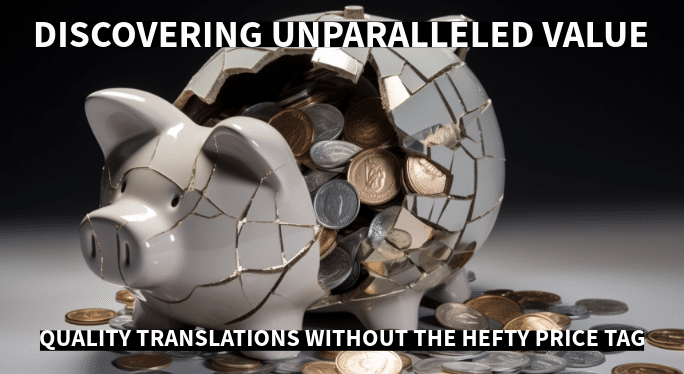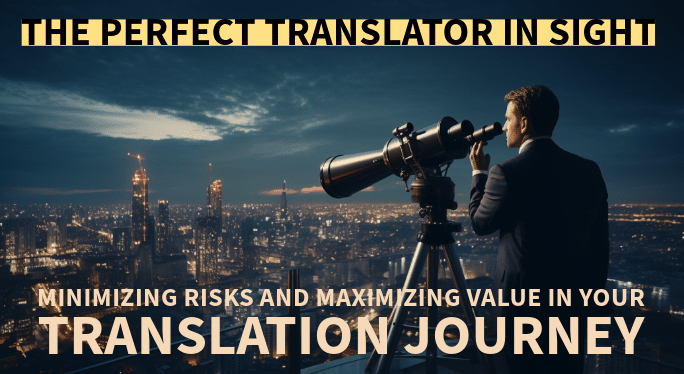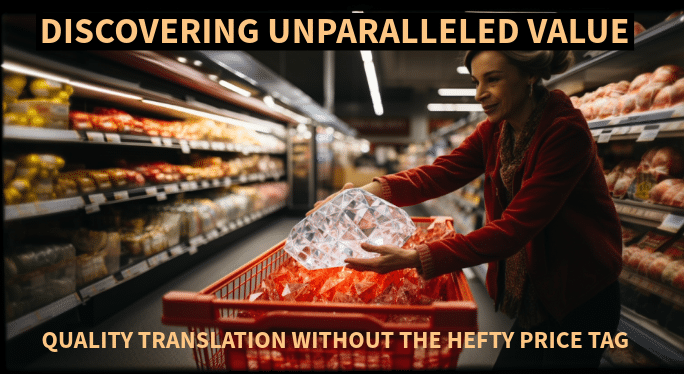
Introduction
Quality translation involves the accurate rendering of source content into another language while maintaining the structure and cultural nuances of the target language. This goes beyond mere verbatim translation; it involves a thorough comprehension of the original text and the ability to relay the same message in a different language. For instance, a technical manual translated from English to German must retain its instructive tone and clarity in the German language, despite the linguistic differences between the two languages.
The importance of quality translation cannot be overstated. It facilitates effective communication, particularly in a globalized world where businesses often have to interact with partners, clients, or customers speaking different languages. More importantly, quality translation can enhance a business’s reputation by demonstrating professionalism and attention to detail.
On the contrary, translation errors can lead to misunderstandings, legal issues, and financial losses. For example, a poorly translated legal contract might result in a dispute due to discrepancies in the interpretation of terms.
Preparation for a Quality Translation
Quality translation begins with quality original documents. Clear, legible, and well-structured source documents yield better translation outcomes. For instance, a well-written business proposal in English is likely to produce a high-quality translation because the translator has a clear understanding of the document’s content and intent.
Organizing your files systematically is another crucial step in the translation process. Well-organized files minimize confusion, enhance translation accuracy, and speed up the process. It’s advisable to group related documents together and name them appropriately. For example, instead of sending a jumbled mix of marketing brochures, product descriptions, and legal contracts, sort them into separate folders labeled according to their content or purpose.
Setting realistic deadlines is also crucial. Rushing the translation process can lead to errors and inaccuracies, which can be costly to rectify. Allocating sufficient time for the translation allows for thorough work, including proofreading and revisions. For example, a 10,000-word technical manual might require at least a week to translate accurately, depending on the complexity of the content and the translator’s expertise.
Finally, eliminating repetitive or irrelevant content can reduce translation time and costs. A concise and relevant document is not only easier to translate but also more likely to hold the reader’s attention. For instance, if a product description repeats the same information in several sections, it’s advisable to consolidate the information to avoid unnecessary translation costs.
Utilizing Translation Memory
Translation memory (TM) is a software tool that stores translated phrases or segments for future use. It’s particularly beneficial for large projects or ongoing translations requiring consistency. For instance, if a company regularly translates product manuals into various languages, a TM tool can store commonly used phrases or terms, ensuring consistent use across all translations.
The benefits of translation memory are manifold. It improves consistency across translations, speeds up the translation process, and helps cut costs by reusing previously translated content. For example, a business that frequently translates press releases into Spanish could significantly reduce translation time and costs by using a TM tool. This tool would automatically fill in previously translated segments, leaving only new content for the translator to handle.

Finding the Right Translator
Choosing the right translator for your documents is vital. Factors to consider include the translator’s expertise in your field, their experience, language proficiency, and understanding of cultural nuances. For instance, a legal document should ideally be translated by a professional with a background in law to ensure accurate translation of legal jargon and concepts.
Choosing a translator based solely on price can be misleading. Cheaper services may compromise on quality, which could result in potential damage to your business image. For example, a poorly translated marketing brochure might give potential customers a negative impression of your brand, even if you offer high-quality products or services.
Cheap translation services often come with risks, including poor quality work, lack of professional expertise, and inconsistencies in translation. For instance, a budget translation service might deliver a translated document littered with grammatical errors, incorrect terminology, and awkward phrasing, all of which could impact the document’s readability and effectiveness.
Tips for Budgeting Translation Services
Budgeting for translation services requires careful consideration of several factors. These include the type of project, language combination, and target audience. For example, translating a technical manual from English to Chinese might cost more than translating a simple email because of the complexity of the content and the higher rates for less common language pairs.
Working with professional translators can often be more cost-effective in the long run. Experienced professionals bring industry knowledge, language proficiency, and cultural understanding, which can help ensure a high-quality translation. For instance, a professional translator with expertise in medical translation can accurately translate medical jargon and adhere to the strict regulatory standards in the healthcare industry.
Requesting quotes from multiple translation agencies and negotiating prices can also help secure affordable and quality services. However, it’s important to remember that the cheapest option might not always provide the best value.
Various factors influence the cost of hiring a professional translation agency, including the language pair, the technicality of the subject, urgency, and formatting requirements. For example, a rush job for a complex legal document in a rare language pair will likely cost more than a non-urgent translation of a straightforward email in a common language pair.
Financial Translation Tips
Financial translation involves translating financial documents, such as annual reports, tax reports, and insurance policies, into another language. This type of translation requires a deep understanding of financial terminology and concepts, as well as local regulations. For instance, a financial translator working on a company’s annual report for a foreign market should be familiar with the accounting standards and financial terminology in the target language.
Financial translation comes with several challenges, including maintaining the tone of voice, meeting tight deadlines, ensuring accuracy, and protecting data security. Common errors to avoid include inconsistent use of financial terminology, inaccuracies in numbers, and formatting differences that might confuse the reader. For example, a translator should be careful with numbers, as different countries use different formats for dates and decimals.
Translation services and software play a crucial role in financial translation. They help maintain consistency, ensure accuracy, and protect confidentiality. For instance, a translation memory tool can store commonly used financial terms and phrases, ensuring their consistent use across a company’s financial documents.
Technical Translation Tips
A translator handling technical documents should preferably have a technical background. This is because technical translation often involves complex terminology and concepts that a translator without a technical background might not fully understand. For example, a technical manual for a piece of machinery would best be translated by someone with knowledge in mechanical engineering.
Translation memory tools can also be useful in technical translation. They help save costs by storing and reusing previously translated technical terms and phrases. For instance, if a company regularly produces user manuals for its products, a translation memory tool can store the translations of commonly used instructions, speeding up the translation process for future manuals.
Repurposing existing materials can also save on translation costs. If a company has previously translated similar documents, it can use these as a reference for new translations. For example, a software company updating its user guide can reuse sections from the old guide that still apply to the new version, reducing the amount of new content that needs translating.
Legal Translation Tips
Accuracy is crucial in legal translation, and this extends to the use of precise legal terminology. Any errors or ambiguities can lead to legal disputes or other serious consequences. For instance, the mistranslation of a single term in a contract could change the entire meaning of a clause, potentially leading to costly legal issues.
Having an additional proofreader can help ensure accuracy in legal translations. This second pair of eyes can catch any mistakes or inconsistencies that the translator might have missed. For example, legal documents often repeat certain phrases or clauses, and a proofreader can help ensure that these are translated consistently throughout the document.
Confirming the translator’s certifications and credentials is also important. Many legal documents require certified translation, which can only be provided by a translator with the necessary qualifications. For instance, a legal contract for use in a court case might require a certified translation to be accepted as evidence.
Marketing Translation Tips
When translating marketing content, it’s important to ensure that the tone and messaging are culturally appropriate for the target audience. This involves more than just translating the words; it requires an understanding of the cultural context and consumer behavior in the target market. For instance, a catchy slogan in English might not resonate with consumers in Japan if it’s translated literally, without considering cultural nuances.
Working closely with the marketing team can help ensure that the translated content meets the company’s marketing objectives. The marketing team can provide valuable insight into the target audience, the intended message, and the overall marketing strategy. For example, if the marketing team is planning a campaign targeting young consumers in Spain, the translator should use a casual and youthful tone that resonates with this demographic.
Prioritizing the most visible marketing content can help manage translation costs. For instance, it might be more cost-effective to first translate the website homepage, product descriptions, and promotional materials before moving on to less visible content like blog posts or FAQs.
Website Translation Tips
When translating a website, it’s advisable to start with the most necessary website copy. This includes key pages like the homepage, product or service pages, and contact information. For instance, a company expanding into the French market might first translate its homepage and product pages into French, leaving the blog posts or news section for later.
Using easy-to-update translation plugins can streamline the website translation process. These plugins automatically detect and translate new content, saving time and effort. For example, a website with regularly updated news or blog posts would benefit from a translation plugin that automatically translates new posts into the selected languages.
Focusing on high-traffic pages first can also help manage translation costs. These are the pages that most visitors see, so translating them first can have the biggest impact. For example, a company’s ‘About Us’ page might receive less traffic than its product pages, so it would make sense to prioritize the translation of the product pages.
Certified Translation Tips
For official documents like birth certificates, legal contracts, or academic transcripts, certified translation is often required. A certified translation is accompanied by a signed statement from the translator or translation agency attesting to the accuracy of the translation. For example, a student applying to a university in another country might need to provide a certified translation of their academic transcripts.
It’s important to confirm the certification requirements upfront, as different organizations or countries may have different requirements. Some might require the translator to be certified by a specific organization, while others might accept a signed statement from the translator attesting to the accuracy of the translation. For example, a legal document for use in a French court might require a certified translation by a translator accredited by the French Ministry of Foreign Affairs.
Allowing sufficient time for the certification process is also critical. Certified translation often takes longer than regular translation, as it requires additional steps like the preparation of the certification statement and, in some cases, notarization. For example, if a couple is planning to get married in Spain and needs to provide a certified translation of their birth certificates, they should allow at least a few weeks for the translation and certification process.
Business Translation Tips
For businesses operating in multiple languages, translating essential documents like presentations, emails, and contracts can help ensure effective communication with partners, clients, or customers. For example, a German company negotiating a contract with a Chinese supplier might need to translate the contract into Chinese to ensure that both parties fully understand the terms.
Reusing previous translations where possible can help save on translation costs. If a company regularly produces similar documents, it can use previous translations as a reference for new translations. For example, a company that frequently sends similar emails to its foreign clients can create a template with pre-translated phrases or paragraphs, reducing the need for new translations.
Having a designated point person to liaise with the translator can streamline the translation process. This person can provide the translator with any necessary information, answer their questions, and review the translated documents. For instance, a marketing manager overseeing a multilingual marketing campaign might work closely with the translator to ensure that the translated content aligns with the campaign’s objectives.

Conclusion
Quality translation on a budget is achievable with careful planning, the right resources, and an understanding of the translation process. The key is to start with clear, well-organized source documents, set realistic deadlines, and eliminate any unnecessary content.
Utilizing translation memory can further improve consistency and save time, while choosing the right translator based on their expertise and experience can ensure a high-quality outcome.
Budgeting for translation services involves considering various factors, from the type of project to the language pair and target audience.
Finally, understanding the specific challenges and requirements of different types of translation, from financial to technical, legal, and marketing, can help ensure a successful translation project.
